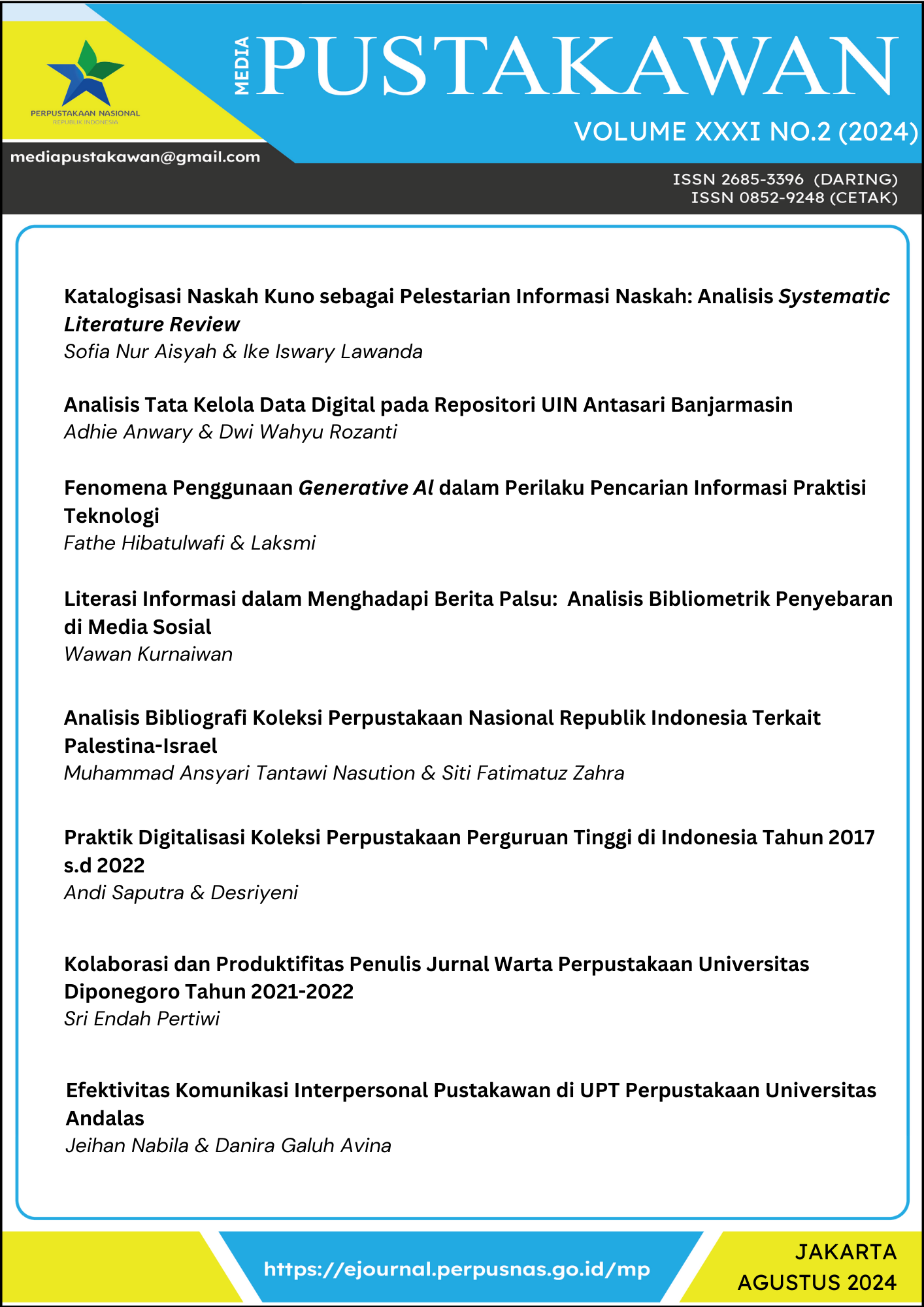Analisis Tata Kelola Data Digital pada Repositori UIN Antasari Banjarmasin
DOI:
https://doi.org/10.37014/medpus.v31i2.5128Keywords:
digital continuity, digital repository, digital governance, digital accessibility, UIN AntasariAbstract
This study aims to analyze digital data governance at the UIN Antasari Banjarmasin repository, digital data sustainability is one of the elements of knowledge management, this research uses the vosviewer application first to map the relationship between subjects related to digital data sustainability. the research method uses a qualitative approach with the research subjects, namely 3 managers of the digital repository of the UIN Antasari Banjarmasin library, research data collection in March-April 2023, data collection techniques: primary & secondary data. Primary data is collected through primary sources, namely interviews with repository managers and observations of repositories and eprints systems. Secondary data is collected with the results of previous research both from ebooks and books, journals, elements of digital data sustainability, namely all information must be open, information must also be complete and the information provided must be available whenever needed. The results of the research found related to the sustainability of digital data in the repository of UIN Antasari Banjarmasin are the need for awareness from the institution towards digital data management as a valuable asset, the importance of a shared understanding from the repository manager to the leadership towards the sustainability of digital data in higher education libraries, policies and sop related to digital information management need to be made and followed up so that the information storage space becomes effective and efficient, must be done.References
Agustiawan. (2016). Buku pedoman pengelolaan repositori institusi di UPT Perpustakaan ISI Yogyakarta. Institut Seni Indonesia.
Bahartiar, B., & Arwadi, F. (2020). Analisa data penelitian kualitatif: Konsep, teknik, prosedur analisis. Universitas Negeri Makasar.
Dalbello, M. (2002). Is there a text in this library? History of the book and digital continuity. Journal of Education for Library and Information Science, 43(3), 197-206. https://doi.org/10.2307/40323963
Gatenby, P. (2002). Digital continuity: The role of the National Library of Australia. Australian Library Journal, 51(1), 21–30. https://doi.org/10.1080/00049670.2002.10755974
Golafshani, N. (2003). Understanding reliability and validity in qualitative research. The Qualitative Report, 8(4), 597–607.
Harvey, R., & Weatherburn, J. (2018). Preserving digital materials (3rd ed.). Rowman & Littlefield.
Hasan, N. (2016). Repositori digital pada perguruan tinggi: Institut Teknologi Sepuluh Nopember (ITS). Raden Patah.
Iskandar. (2009). Metodologi penelitian kualitatif. Gaung Persada (GP Press).
Kruk, M., & Krzysztof, G. (2016). Institutional repositories: The role of institutional repositories in the digital environment. Journal of Information Science and Technology, 14(2), 45–58. https://doi.org/10.1234/jist.2016.14.2.45
Leedy, P. D., & Ormrod, J. E. (2015). Practical research: Planning and design (11th ed.). Pearson.
MacLean, M., & Davis, B. H. (1998). Time and bits: Managing digital continuity. In Finding a viable technical foundation for digital continuity (pp. 11-16). Los Angeles.
Moleong, L. J. (2018). Metodologi penelitian kualitatif (edisi revisi). Remaja Rosda Karya.
National Archives of Australia. (2011). Digital transition and digital continuity.
Palfrey, J. (2015). Bibliotech: Why libraries matter more than ever in the age of Google. Basic Books.
Pemerintah RI. (2007). Undang-undang No 43 tentang Perpustakaan. https://jdih.perpusnas.go.id/file_peraturan/UU_No._43_Tahun_2007_tentang_Perpustakaan_.pdf
Popper, K. (2013). The open society and its enemies (1st ed.). Princeton University Press.
Purwaningtyas, F. (2014). Aset informasi perpustakaan (Tata kelola & keamanan). Visi Pustaka, 16(2).
Queensland State Archives. (2012). Queensland government digital continuity strategy: Future proofing the critical digital records of government business. Queensland.
Rahayu, S. (2017). Mengenal perpustakaan perguruan tinggi lebih dekat. Buletin Perpustakaan, (57), 103-110.
Rahmadi. (2011). Pengantar metodologi penelitian. Antasari Press.
Rubin, R. E. (2016). Foundations of library and information science (4th ed.). American Library Association.
Rubin, R. E., & Rubin, R. G. (2020). Foundations of library and information science. American Library Association.
Sarosa, S. (2017). Metodologi pengembangan sistem informasi. Indeks.
Setiawan, A. B. (2014). Perencanaan strategis sistem informasi pada pusat penanganan insiden keamanan informasi sektor pemerintah. Jurnal Masyarakat Telematika dan Informasi, 5(1), 1–24.
Siebel, T. M. (2019). Digital transformation: Survive and thrive in an era of mass extinction. RosettaBooks.
The National Archives. (2017). Embedding digital continuity in information management. The National Archives.
The National Archives. (2017). Managing digital continuity. The National Archives.
The National Archives. (2017). Understanding digital continuity. The National Archives.
The National Archives. (2017). What is digital continuity. The National Archives.
Ulum, A., & Kurniawan, E. (2016). Analisis konten dan kebijakan akses institutional repositori. Jurnal Pustakaloka.
Upward, F., McKemmish, S., & Reed, B. (2011). Archivists and changing social and information spaces: A continuum approach to recordkeeping and archiving in online cultures. Archivaria, 72, 197–237.
Downloads
Published
How to Cite
Issue
Section
License

This work is licensed under a Creative Commons Attribution-NonCommercial-ShareAlike 4.0 International License.








